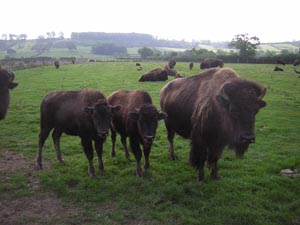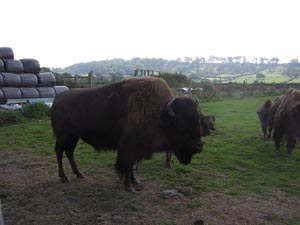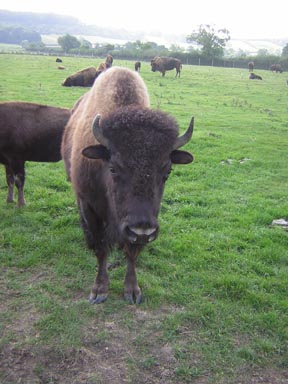
Hundreds of motorists each day travelling on the A606 between
Melton Mowbray and Nottingham little realise that as they approach the village of Nether Broughton they are within 50 –100 yards of a field of Bison. Furthermore on the hills overlooking the road over 400 red deer roam. These animals belong to George and Ruth Wakeling who some 10 years ago completely changed the way in which their farm, Bouverie Lodge, was farmed.
At that time the Government, and successive ones too, was urging farmers to diversify and move away from commodity products and explore niche markets. At the same time there was pressure on the red meat industry over high fat and cholesterol levels.
As George explained for many 100's of years cattle had been farmed and bred for confirmation and meat yield which had unwittingly led to increased fat and cholesterol levels.
It was clear to George that the way to go was 'back to animals as nature intended'. This idea coincided with him running across an article published by the Canadian Bison Association. He followed this up by contacting the British Bison Association and after further research decided to put his hand to Bison Farming.
He started with six North American bison which he purchased from a Devon producer and through further purchases of breeding stock now runs a herd of over 100 beasts. By bringing in new breeding stock he has largely avoided the problems of close breeding and in fact has improved his stock.

The bison are out to grass most of the year the only supplement offered being extra minerals. Although bison can cope with extremely cold weather they do not like the wet UK winters. Thus form late October/November the bison are brought inside into large pole barns. Because the bison have a strict hierarchy, similar to the peck order with chickens, they need around four times as much space as cattle. It takes between 24 and 30 months before the bison are ready for slaughter and here begins the problems for UK bison producers.
To farm bison it is necessary to have a Wild Animal Licence this was no problem. However, under EU/UK legislation bison are treated as normal bovines despite the fact that they are not classed as a domesticated species.
First problem is tagging bison calves. This cannot be done at birth since the bison cows are too aggressive and will protect their calves from any intrusion. Fortunately in their wisdom the authorities provide a derogation that allows bison to be tagged at 9 months. This might seem a reasonable way out but it is extremely stressful not to say dangerous to tag a nine-month-old bison. The stress being as much with the bison as the staff carrying out the tagging! However, despite these problems all the bison are tagged by nine months of age.

The second and what at the time of writing seems almost insurmountable are the latest regulations regarding the slaughter of bison. Initially the animals would be slaughtered on farm and taken to a local butcher, the carcases then returned to Bouverie Lodge where the meat would be prepared and packed. Unfortunately the local butcher is no longer prepared to take in the bison.
The problem has arisen that when bison are slaughtered on farm once killed they are treated as a bovine casualties. None of the local abattoirs want to deal with bovine casualties due to the regulations surrounding how bovine casualties must be treated. Thus the bison must be taken to a slaughterhouse, as is the case with cattle. Clearly the authorities felt that as bison were undoubtedly bovines they should be treated exactly the same as cattle.
Not so says George since bison are not domesticated their stress levels are much higher than cattle when awaiting slaughter at a slaughterhouse. The effect is that the levels of corticosteroids reach such high levels that the quality of the meat is affected rendering it, in his opinion, unsaleable. But as important the stress on the animals at slaughter as required by the authorities goes against basic animal welfare principles which state that at slaughter stress to animals should be minimised.
"With bison the opposite is the case," says George Wakeling citing the current legislation which states in the Welfare of Animals (Slaughter and Killing) Regulations:
Humane treatment of animals
4.- (1) No person engaged in the movement, lairaging, restraint, stunning, slaughter or killing of animals shall-
(a) cause any unavoidable excitement, pain or suffering to any animal;or
(b) permit any animal to sustain any avoidable excitement, pain or suffering"
However, he believes there is a simple solution to treat bison as Farmed Game as are his herd of red deer. This would solve the problem for UK bison farmers at a stroke. Despite his many representations George has yet to succeed but continues the battle. As he explained he understands and supports the need for stringent meat hygiene regulations. But, in the case of what is a very small sector, the regulations stand in the way of him continuing to make a living from a niche market which successive Governments have urged farmers to become involved with.
Facts about bison
• Largest mammals in North America up 7ft tall weighing 2000lbs
• Males are twice the size of cows
• Bison can run as fast as horses and easily outmanoeuvre them
• The hump on the back is a large shoulder muscle that holds up the bison's head
• Horns can grow to 3ft
• Bison grunt not bellow
• Calves are red when born
• Bison can live and produce calves up to 30 years of age
Bison meat produced at Bouverie is marketed direct to the public via farmers markets and at various events and agricultural shows throughout the UK. The meat is full of flavour but sweeter than beef and is low in fat, calories and cholesterol. However, there are drawbacks since bison is produced in relatively small quantities it falls into the ' Gourmet' category.
"The value of bison meat is not what you pay but what you get in return. With 35% more protein than beef you eat a third less to satisfy you appetite," explained George.
Because it is much lower in fat than beef high temperatures are not needed to cook bison. For example whereas beef would be roasted at 325 deg F/165 deg C for bison temperatures can be reduced to 275/140 respectively.
Venison at Bouverie Lodge
The second activity, farmed venison, was chosen again for the quality of the meat. Being a lean meat venison is rich in omega 3 fatty acids as well as iron which gives it its dark colour. Unlike the bison the deer come under the Farmed Game regulations.
